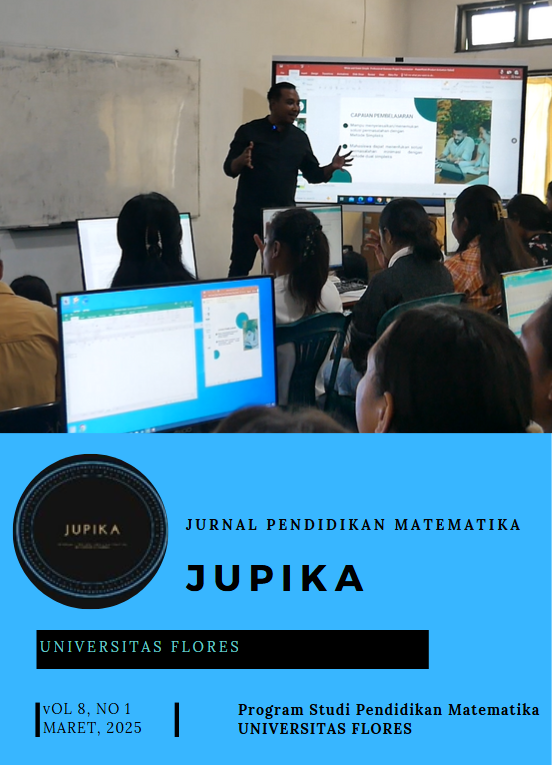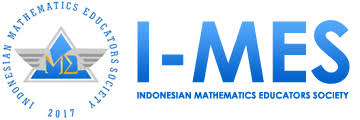SYSTEMATICS LITERATURE REVIEW: EFEKTIVITAS WORKED EXAMPLE DALAM PEMBELAJARAN MATEMATIKA
DOI:
https://doi.org/10.37478/jupika.v8i1.5407Abstract
This study aims to determine the effectiveness of worked examples in mathematics learning and its impact on improving students' learning abilities in mathematics learning. The method used in this research is Systematic Literature Reviews (SLR). Identifying, selecting and determining selected articles from the database followed the PRISMA flow diagram with the established inclusion criteria. Of the 12 articles selected in this study, learning with worked examples was effective in 11 research articles, while 1 other article reported it was ineffective. In addition, worked examples have a positive impact in mathematics learning and have been proven effective in improving learning achievement, understanding, problem solving, proportional reasoning, representation and learning independence in mathematics learning.
Downloads
Keywords:
Worked Example, Mathematics EducationReferences
Andini, P. A., Novaliyosi, N., & Santosa, C. A. H. F. (2024). Kemampuan Pemecahan Masalah Matematis dengan Worked example: Systematic Literature Review. Jurnal Lebesgue: Jurnal Ilmiah Pendidikan Matematika, Matematika dan Statistika, 5(2), 1154-1162. https://doi.org/10.46306/lb.v5i2.689
Anisa, R., & Retnowati, E. (2024). Pengaruh metode integrated worked example terhadap kemampuan pemecahan masalah dan cognitive load. Jurnal Pengembangan Pembelajaran Matematika, 6(1), 14-26. https://doi.org/10.14421/jppm.2024.61.14-26
Atkinson, R. K., Derry, S. J., Renkl, A., & Wortham, D. (2000). Learning from Examples: Instructional Principles from the Worked examples Research. Review of Educational Research, 70(2), 181-214. https://doi.org/10.3102/0034654307000218
Asrafil, A., Guntur, M. I. S., & Wicaksono, A. B. (2021). Optimization of Worked example-Problem Solving Pair to Increase Learning Independence and Reduce Cognitive Load. Indonesian Journal of Mathematics Education, 4(2), 53-65. https://doi.org/10.31002/ijome.v4i2.6246
Azizah, N., Rosyid, A., & Noorfitriani, I. (2020). Perbandingan kemampuan pemahaman matematis siswa melalui penerapan pembelajaran guided discovery, worked example, dan scientific. SJME (Supremum Journal of Mathematics Education), 4(2), 159-169. https://doi.org/10.35706/sjme.v4i2.3551
Brunken, R., Plass, J. L., & Moreno, R. (2010). Current issues and open questions in cognitive load research. In J. L. Plass, R. Moreno, & R. Brunken (Eds.), Cognitive Load Theory (pp. 253-272). Cambridge: Cambridge University Press.
Chen, I. J., & Chang, C. C. (2009). Cognitive load theory: An empirical study of anxiety and task performance in language learning. Electronic Journal of Research in Educational Psychology, 7(2), 729-746. https://doi.org/10.25115/ejrep.v7i18.1369
deJong, T. (2010). Cognitive load theory, educational research, and instructional design: some food for thought. Instructional Science, 38, 105-134. https://doi.org/10.1007/s11251-009-9110-0
Fang-Tzu Hu, P. G., & Bobis, J. (2015). Getting the point: Tracing worked examples enhances learning. Learning and Instruction, 35, 85-93. https://doi.org/10.1016/j.learninstruc.2014.10.002
Ibrahim, B. K., & Amir, M. F. (2024). Penalaran Proporsional Siswa dalam Strategi Worked example. Jambura Journal of Mathematics Education, 5(1), 50-61. https://doi.org/10.37905/jmathedu.v5i1.23798
Intan, I. N., & Rosyid, A. (2020). Peningkatan kemampuan pemahaman matematis siswa menggunakan worked example. Mathline: Jurnal Matematika dan Pendidikan Matematika, 5(1), 26-36. https://doi.org/10.31943/mathline.v5i1.127
Irwansyah, M. F., & Retnowati, E. (2019). Efektivitas worked example dengan strategi pengelompokan siswa ditinjau dari kemampuan pemecahan masalah dan cognitive load. Jurnal Riset Pendidikan Matematika, 6(1), 62-74. https://doi.org/10.21831/jrpm.v6i1.21452
Kalyuga, S. (2009a). Managing Cognitive Load in Adaptive Multimedia Learning. New York, NY: Information Science Reference.
Kalyuga, S. (2009b). Cognitive Load Factors in Instructional Design for Advance Learner. New York, NY: Nova Science Publishers.
Kalyuga, S. (2011). Informing: A cognitive load perspective. Informing Science: the International Journal of an Emerging Transdiscipline, 14(1), 33-45. https://doi.org/10.28945/1349
Kester, L., Paas, F., & Merrienboer, J. J. G. v. (2010). Instructional control of cognitive load in the design of complex learning environments. In J. L. Plass, R. Moreno, & R. Brunken (Eds.), Cognitive Load Theory (pp. 109-130). Cambridge: Cambridge University Press.
Kirschner, P. A., Sweller, J., & Clark, R. E. (2006). Why minimal guidance during instruction does not work: An analysis of the failure of constructivist, discovery, problem-based, experiential, and inquiry-based teaching. Educational Psychologist, 41(2), 75-86. https://doi.org/10.1207/s15326985ep4102_1
Lame, G. (2019, July). Systematic literature reviews: An introduction. In Proceedings of the design society: international conference on engineering design (Vol. 1, No. 1, pp. 1633-1642). Cambridge University Press. https://doi.org/10.1017/dsi.2019.169
Leonard, L. (2015). Cognitive load and asperger’s: Teaching relevance. Journal of Student Engagement: Education Matters, 5(1), 12-17. https://ro.uow.edu.au/jseem/vol5/iss1/3
McLaren, B. M., Gog, T. v., Ganoe, C., Karabinos, M., & Yaron, D. (2016). The efficiency of worked examples compared to erroneous examples, tutored problem solving, and problem solving in computer-based learning environments. Computers in Human Behavior, 55, 87-99. https://doi.org/10.1016/j.chb.2015.08.038
Methley, A. M., Campbell, S., Chew-Graham, C., McNally, R., & Cheraghi-Sohi, S. (2014). PICO, PICOS and SPIDER: a comparison study of specificity and sensitivity in three search tools for qualitative systematic reviews. BMC health services research, 14(1), 1-10. https://doi.org/10.1186/s12913-014-0579-0
Moreno, R., & Park, B. (2010). Cognitive load theory: Historical development and relation to other theories. In J. L. Plass, R. Moreno, & R. Brunken (Eds.), Cognitive Load Theory (pp. 9-28). Cambridge: Cambridge University Press.
Mulder, Y. G., Lazonder, A. W., & Jong, T. d. (2014). Using heuristic worked examples to promote inquiry-based learning. Learning and Instruction, 29, 56-64. https://doi.org/10.1016/j.learninstruc.2013.08.001
Nightingale, A. (2009). A guide to systematic literature reviews. Surgery (Oxford), 27(9), 381-384. https://doi.org/10.1016/j.mpsur.2009.07.005
Nuraeni, Z., Simarmata, R. H., & Tarigan, A. H. Z. (2023). Implementation Worked example-Based Learning to Improve Junior High School Students' Mathematical Representation Ability. Jurnal Pendidikan Matematika (JUPITEK), 6(1), 36-41. https://doi.org/10.30598/jupitekvol6iss1pp36-41
Nuraeni, Z., Simarmata, R. H., & Tarigan, A. H. Z. (2023). Pengembangan Worksheet Berbasis Worked example Untuk Meningkatkan Kemampuan Representasi Matematis Siswa SMP. Jurnal Silogisme: Kajian Ilmu Matematika dan Pembelajarannya, 8(2), 67-75. https://doi.org/10.24269/silogisme.v8i2.6166
Retnowati, E. (2008). Keterbatasan memori dan implikasinya dalam mendesain metode pembelajaran matematika. Makalah disajikan dalam Seminar Nasional Matematika dan Pendidikan Matematika. Universitas Negeri Yogakarta 28 November 2008. http://eprints.uny.ac.id/id/eprint/6895
Retnowati, E. (2012). Worked examples in mathematic. Makalah disajikan dalam 2nd International STEM in Education Conference. Beijing Normal University tanggal 24-27 Novemer 2012.
Santosa, C. A. H. F., Rafianti, I., & Yulistiany, D. (2022). Worked-example method on mathematical problem-solving ability in term of students’ initial ability. Kreano, Jurnal Matematika Kreatif-Inovatif, 13(2), 210-220. https://doi.org/10.15294/kreano.v13i2.33301
Santosa, C. A. H. F., Suryadi, D., Prabawanto, S., & Syamsuri, S. (2018). The role of worked-example in enhancing students' self-explanation and cognitive efficiency in calculus instruction. Jurnal Riset Pendidikan Matematika, 5(2), 168-180. https://doi.org/10.21831/jrpm.v0i0.19602
Sirajuddin, S., & Sari, N. (2022). Pengembangan Media (LKS) untuk Meningkatkan Hasil Belajar Siswa Sekolah Menengah Pertama (SMP) Kelas VIII Menggunakan Pendekatan Worked examples. Jurnal Ilmiah Telaah, 7(2), 237-246. https://doi.org/10.31764/telaah.v7i2.10484
Sweller, J. (2010). Cognitive Load Theory: Recent Theoretical Advances. In J. L. Plass, R. Moreno, & R. Brunken (Eds.), Cognitive Load Theory (pp. 28-47). Cambridge: Cambridge University Press.
Sweller, J., Ayres, P., & Kalyuga, S. (2011). Cognitive load theory. London: Springer.
Van Gog, T., Paas, F., & Sweller, J. (2010). Cognitive load theory: Advances in research on worked examples, animations, and cognitive load measurement. Educational Psychology Review Springer, 1-4. https://doi.org/10.1007/s10648-010-9145-4
Young, J. Q., Merrienboer, J. V., Durning, S., & Cate, O. T. (2014). Cognitive Load Theory: Implications for medical education. Medical Teacher, 36, 371–384. https://doi.org/10.3109/0142159X.2014.889290
Downloads
Published
How to Cite
Issue
Section
License
Copyright (c) 2025 Nur Azizah, Aditya Prihandhika

This work is licensed under a Creative Commons Attribution-NonCommercial-ShareAlike 4.0 International License.
![]() JUPIKA: JURNAL PENDIDIKAN MATEMATIKA is licensed under a Creative Commons Attribution-ShareAlike 4.0 International License.
JUPIKA: JURNAL PENDIDIKAN MATEMATIKA is licensed under a Creative Commons Attribution-ShareAlike 4.0 International License.










